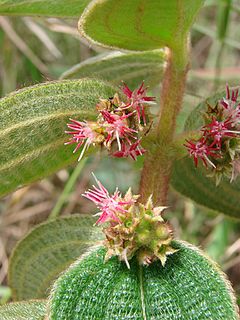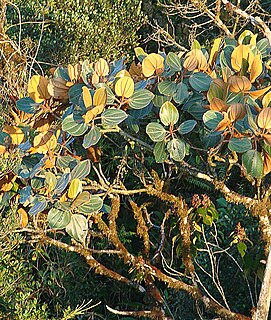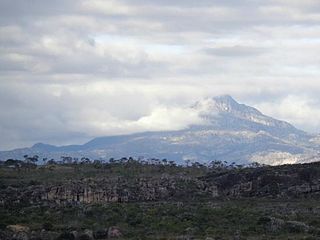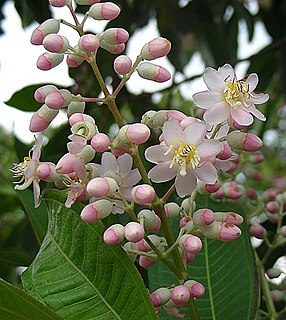
Minas Gerais is a state in Southeastern Brazil. It ranks as the second most populous, the third by gross domestic product (GDP), and the fourth largest by area in the country. The state's capital and largest city, Belo Horizonte, is a major urban and finance center in Latin America, and the sixth largest municipality in Brazil, after the cities of São Paulo, Rio de Janeiro, Salvador, Brasília and Fortaleza, but its metropolitan area is the third largest in Brazil with just over 5,800,000 inhabitants, after those of São Paulo and Rio de Janeiro. Nine Brazilian presidents were born in Minas Gerais, the most of any state. The state has 10.1% of the Brazilian population and is responsible for 8.7% of the Brazilian GDP.

Melastomataceae is a family of dicotyledonous flowering plants found mostly in the tropics comprising c. 165 genera and c. 5115 known species. Melastomes are annual or perennial herbs, shrubs, or small trees.

Miconia is a genus of flowering plants in the glory bush family, Melastomataceae, native to warm temperate to tropical regions of the Americas. The species are mostly shrubs and small to medium-sized trees up to 15 m tall. The generic name honours Catalan physician and botanist Francesc Micó. Some species are known by the common name johnnyberry.

Formoso is a municipality in northern Minas Gerais state, Brazil. It is located northeast of Brasília, in a pocket where the boundaries of the states of Minas Gerais, Goiás, and Bahia come together.

The Espinhaço Mountains are a mountain range in Brazil. The range runs roughly north and south through the states of Minas Gerais and Bahia, extending for approximately 1,100 km (680 mi). It forms the divide between the upper watershed of the São Francisco River and those of the shorter rivers which flow east into the Atlantic Ocean, including the Doce, the Jequitinhonha, and the Pardo rivers. Pico do Sol, its highest peak, rises to 2,072 metres (6,798 ft), in Catas Altas town. The historical town of Diamantina are located in the Espinhaço Mountains. The Espinhaço Mountains were a major via through which Minas Gerais was settled during the Gold Rush of the 18th century.

Ossaea is a genus of flowering plants in the family Melastomataceae. There are about 90 species distributed from Mexico to South America and the Caribbean.

Lagamar is a municipality in the north of the Brazilian state of Minas Gerais. Its population in 2020 was 7,600 inhabitants in a total area of 1,425 km2 (550 sq mi). It is a large producer of cattle and grains and there is extraction of phosphates.

Maria da Fé is a Brazilian municipality located in the state of Minas Gerais. Its population as of 2020 is estimated to be 14,056 people. The area of the municipality is 203.774 km². The city belongs to the mesoregion South/South-West of Minas Gerais and to the microregion of Itajubá.

Bertolonia is a genus consisting of 14 species of pretty, dwarf, creeping, tender perennials, native to tropical South America. These herbaceous plants are grown for their colorful, velvety, ornamental foliages, vary from shimmery white with purple, pink with purple, or bronze-green with carmine and lighter midribs, purple beneath. Leaves are coarsely hairy, oval 7 cm (3 in) long on short stalks. The plants bear clusters of small, bell-shaped flowers repeatedly, just above the leaves, color ranges from pink, red, yellow to purple.
Antiblemma leucocyma is a moth of the family Noctuidae first described by George Hampson in 1926. It is native to Brazil. It has been studied as a potential biological control agent for Miconia calvescens, an invasive tree considered one of the greatest threats to natural ecosystems of Hawaii and other Pacific islands.

Nanuque is a municipality in the state of Minas Gerais, in the southeastern region of Brazil, belonging to Mucuri Valley and Region Nanuque. The relief consists of inselbergs and seas of hills, and the Serra dos Aimorés as predominant characteristic. Considered the 79th most populous city in the state, the 2nd Northeast 1st miner and its region, with 40,665 inhabitants according to the 2020 estimate. According to DENATRAN its fleet is 17,782 motor vehicles. As a regional hub ten municipalities, their total area 116,545 inhabitants and a total area of 8471.872 km ². Nanuque, cut the highway Ox (BR-418), reference is to be en route to the northern coast of Espirito Santo state by state highway LMG-719 and the southern coast of Bahia state by the then federal highway BR-418, of which is 605 km to the northeast of the state capital Belo Horizonte and 1257 km east of the federal capital Brasília.

Graffenrieda is a genus of flowering plants in the family Melastomataceae. There are about 44 species. Most occur in South America. A few are distributed in Mexico, Central America and the Caribbean.

The Pico do Itambé State Park is a state park in the state of Minas Gerais, Brazil. It protects one of the higher peaks in the state.

Miconia albicans is a species of shrub in the family Melastomataceae. It is known as "canela de velho" in Brazilian Portuguese. It is native to North and South America.

Miconia fallax is a species of shrub in the family Melastomataceae. It is native to South America.

Miconia lacera is a species of shrub in the family Melastomataceae. It is native to North and South America.

Miconia theaezans is a species of shrub or tree in the family Melastomataceae. It is native to South America.

Miconia ciliata is a species of shrub in the family Melastomataceae. It is native to North and South America.
Fritzschia is a genus of flowering plants in the family Melastomataceae, native to the Atlantic coastal forest of Brazil. They are sprawling or erect shrubs, with their branchlets and their hypanthia coated with either glandular or villose trichomes.
Myrciaria evanida is a species of plant in the family Myrtaceae. It is endemic to Espírito Santo and Minas Gerais in Brazil. First described in 2013, it resembles Myrciaria floribunda.










